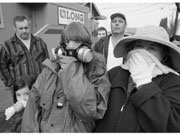IT TOOK ONLY 20 YEARS, but City Hall bureaucrats have suddenly swung into action against the unpermitted operations of Long Painting Co. Although the industrial painting giant’s chemical odors and sandblasting dust have for years aggravated residents surrounding its 5-acre South Park home base, the mostly low-income and cloutless families saw little come from their protests.
Now, urged on by Seattle City Council members responding to chronic neighborhood health complaints and Long Painting’s spotty licensing compliance dating back to the 1980s, city regulatory officials have ordered the industrial painter of warships, bridges, and stadiums to complete an environmental impact review, obtain all city licenses and permits, and answer to its critics in public hearings. Failure to comply could lead to closure of the Northwest’s biggest commercial painting and sandblasting firm.
City inspectors discovered that the company lacked 30 city permits for construction and use of 11 structures at its 10th Avenue South site. Long Painting also did not have any of four required Seattle Fire Department permits, including one for storage of more than 3,500 gallons of flammable materials, Fire Department officials say.
The city action comes in the wake of a Seattle Weekly report on the company’s unpermitted operations and its airborne emissions (“South Park stinks,” SW, 1/4/01). Some neighbors claim that Long Painting’s ear-splitting construction noises, chemical spills, and especially its emission of fumes and blasting dust have seriously compromised their well-being. They point to the company’s ventilation stacks and outdoor painting operations as the suspected cause of ailments ranging from constant headaches to respiratory complications.
On January 16, City Council members Judy Nicastro, Richard Conlin, Jan Drago, and Margaret Pageler said enough is enough. In a letter to the Department of Design, Construction, and Land Use (DCLU), the council members wrote, “Given the history of Long Painting’s compliance, or lack of compliance, with regulatory law, we do not have a sense of assurance that the company will automatically change their ways and be a model neighbor because a permit is granted.”
Any promise by Long Painting to obey city codes, said council members, “seems insufficient.” They asked DCLU to hold additional “proper” and “exhaustive” public hearings on the company’s operations and its planned on-site expansion. They also urged the building department to increase its oversight of the facility and to gather more data to aid health-risk assessments.
“I GOT LOTS OF INPUT from state agencies—ecology and health,” says Charlie McAteer, Nicastro’s aide who drafted the letter. “Basically, what I kept hearing was those people are getting screwed down there.”
A week after the council letter arrived, DCLU announced it was requiring Long Painting to complete an environmental impact statement (EIS) in connection with its expansion application. That’s a disappointing setback for the company, likely meaning increased costs and delays. DCLU spokesman Alan Justad says the department has identified air quality, environmental health, traffic, light, and glare “as elements for discussion” in the environmental review.
The department also announced it would hold a public hearing on the EIS next Monday, February 12, at 7pm at the Concord Elementary School cafeteria in South Park.
Council members urged DCLU to consider a limit on Long Painting’s hours of operation if the company should eventually win approval for its expansion. They also suggested independent and unannounced monitoring of emissions and operations, and creation of a “meaningful” complaint system for neighbors.
Mayor Paul Schell has also taken an interest in the controversy, touring South Park and the Long Painting property last week. Press aide Dick Lilly says the mayor is “studying all these issues” for now.
Yalonda Sinde, executive director of the Community Coalition for Environmental Justice, which has been aiding South Park residents battling the painters, calls the DCLU’s action “a good thing” so far but notes, “We need more concrete details before we consider it a victory.”
Charlie Cunniff, who heads the Environmental Coalition of South Seattle, is seeking a middle ground in the dispute. Cunniff thinks the city’s action may force Long Painting to consider moving from South Park. In a letter to the council, he says, “This company is being constantly lambasted, [even though] they are honestly trying to make changes, and nobody will listen.”
Company officials did not respond to requests for comment. Long Painting Vice President John Fisher earlier said the company has spent $200,000 on biofilters and other environmental systems since he and three other employees bought it in 1998. Fisher previously told the Weekly he believes that for the most part, “neighbors are happy with us.”
Some clearly aren’t. Long Painting’s request last year for a city master use permit to add three new buildings, one sized at 32,500 square feet, set off a renewed round of objections over the company’s operations. The expansion plans led to a land-use challenge by citizens that could restrict company operations and to disclosure of its lapses in obtaining city permits.
Long Painting has already paid $30,000 to settle city claims of past code violations and faces $575 daily fines and other penalties if it fails to obtain necessary permits.
A review of city fire marshal files last week showed that besides a flammable materials storage permit, the company lacks licenses for storage of petroleum, spraying booths, and welding and cutting. Records indicate the permits expired in the 1980s. Long Painting applied for a new flammable materials license in 1992, but it was not issued—in part, the Fire Department says, because city inspectors failed to follow up. Fire Department code compliance officer Tom Campbell says, “It’s a big city, and we [at the fire marshal’s office] are a small staff.”
When on-site inspections were made, they could have lead to a cat-and-mouse game. A 1992 complaint in the Fire Department files claimed Long Painting might “hide their hazardous materials when SFD inspects” the facility. “Try to park around the block,” the tipster advised, “so you can catch them by surprise.”








